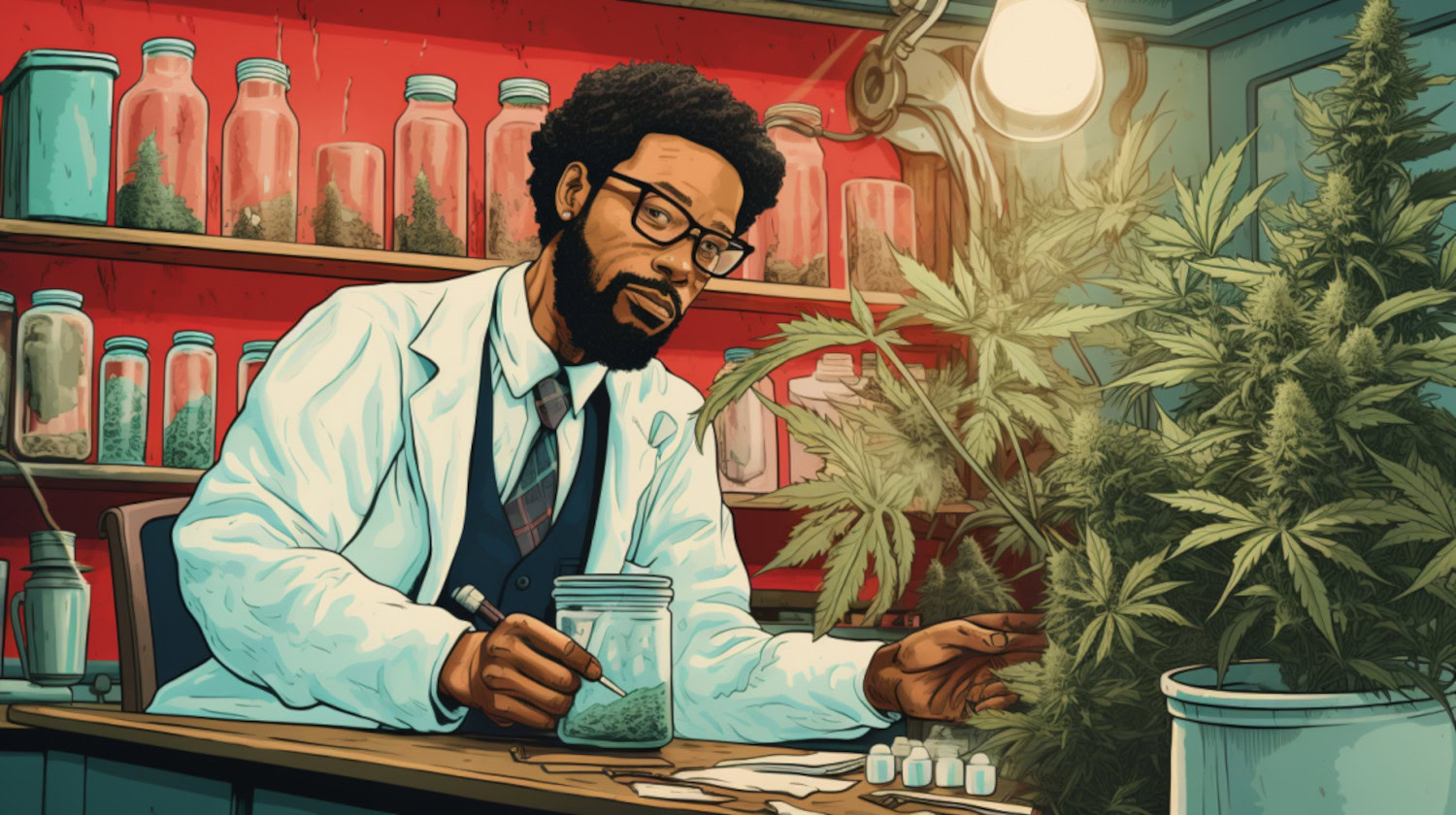In This Article
- Which Terpenes Help Most With Traumatic Brain Injury?
- β-Caryophyllene (BCP)
- Myrcene
- Limonene
- α-Pinene
- Nerolidol
- Which Terpene Combinations Help Most With Traumatic Brain Injury?
- β-Caryophyllene and Myrcene
- Limonene and α-Pinene
- Eucalyptol and Nerolidol
- Nerolidol and Borneol
- How to Choose Strains for Traumatic Brain Injury Based on Terpenes
- Certificate of Analysis
- Terpene Profile
- Cannabinoid Profile
- Personal Tolerance
- Desired Effects
- Past Patient Reviews
- Medication Interactions
- The 5 Best Strains for Traumatic Brain Injury Based on Terpenes
- Remedy
- ACDC
- Twilight
- Maui Bubble Gift
- Lucy
Key Takeaways
- β-Caryophyllene, myrcene, and α-pinene may be essential terpenes for managing TBI symptoms like inflammation and pain.
- Combining terpenes like limonene and nerolidol may enhance therapeutic effects for TBI recovery.
- Remedy, ACDC, and Maui Bubble Gift are among the best strains for TBIs, offering anti-inflammatory and neuroprotective benefits.
There are many cannabis strains and terpene combinations available to patients. Finding the right terpene combination can help narrow down the options and potentially impact how effective a strain or product is.
When dealing with something as serious as a traumatic brain injury (TBI), it's important to find a product for its underlying symptoms. With more access to medical cannabis in many states, some TBI patients have started seeking the best weed for concussions. The right anti-inflammatory terpenes may help patients manage symptoms and improve recovery.
Which Terpenes Help Most With Traumatic Brain Injury?
Research on terpenes specifically for TBIs is still emerging. Several terpenes show promise based on their effects on related conditions. These include inflammation, oxidative stress, and pain—all common symptoms in TBI cases. Knowing which terpenes might be effective is helpful for patients seeking the best weed for concussions.
β-Caryophyllene (BCP)
The most widely researched terpene for neurological conditions is beta-caryophyllene. We understand that it has anti-inflammatory and pain-reducing properties for some patients. In studies, BCP showed significant benefits in mouse models with types of neuropathic pain. Some consider caryophyllene one of the best terpenes for pain and inflammation.1
Myrcene
Myrcene is another terpene with a reputation for its potential health benefits, particularly its sedative-like and muscle-relaxing effects.1 However, its impact can vary depending on the specific condition. As a result, some patients find that myrcene helps them manage TBI-related discomfort.
Limonene
Often recognized for being antifungal and antibacterial, limonene may also help with pain. Studies suggest that it shows promise in certain types of pain management. It may inhibit pain-perceiving behaviors in the brain, which may be helpful for TBI patients experiencing pain.1
α-Pinene
Alpha-pinene stands out for its neuroprotective effects, especially in the context of a TBI. The terpene's antioxidant properties may be particularly beneficial shortly after an injury. Evidence shows it reduced DNA damage in skin cells after UVA light exposure. More research is needed to understand how else it can help with pain, but results thus far are promising.1
Nerolidol
A lesser-known terpene, nerolidol may have neuroprotective and anti-inflammatory benefits similar to alpha-pinene. It hasn't been explicitly studied in TBI models yet, but its effects suggest it could play a role in managing TBI symptoms.1
Although these terpenes haven't been directly tested in TBI models, their results show their potential to help manage TBI-associated symptoms.
Which Terpene Combinations Help Most With Traumatic Brain Injury?

Research on specific terpene combinations for TBIs is still limited. However, existing studies on related conditions provide valuable insights. Likewise, past patient experiences and reviews can help point new patients in the right direction.
β-Caryophyllene and Myrcene
A combination of beta-caryophyllene and myrcene could be effective for TBI patients. First, consider BCP's anti-inflammatory and pain-reducing properties. Then, pair it with myrcene's muscle-relaxing and sedative-like effects.1 The result may be a more rounded approach to managing pain and inflammation. This combo may be beneficial for patients seeking relief from physical discomfort. In addition, it may help with the anxiety that often accompanies TBI recovery.
Limonene and α-Pinene
Pairing limonene with alpha-pinene might be another promising combination. Patients like limonene's potential for pain management and pinene's neuroprotective and antioxidant effects.1 The two may work well together to help further reduce inflammation and oxidative stress after a TBI. Some patients find that the combo may help with pain and support cognitive function and recovery.
Eucalyptol and Nerolidol
Eucalyptol is known for its anti-inflammatory and antimicrobial properties.2 It may work well when combined with Nerolidol's neuroprotective benefits.1 Their combined anti-inflammatory properties may help to reduce brain inflammation and support overall recovery with symptoms like cognitive fog and headaches.
Nerolidol and Borneol
Though nerolidol is less commonly discussed, combining it with borneol may offer unique benefits. Both terpenes have anti-inflammatory and neuroprotective properties.1,3 Together, they might help reduce the brain inflammation often seen after a TBI, which could improve overall recovery.
These terpene combinations may offer enhanced therapeutic effects. Everyone is different, so experiment with various terpene combinations to discover the right one for your needs. More research is needed, but patients exploring terpenes for TBI recovery may find these helpful.
As always, it’s important to consult with a healthcare provider before starting any new treatment regimen.
How to Choose Strains for Traumatic Brain Injury Based on Terpenes
Several factors come into play when choosing a strain for a TBI. These help ensure each patient gets the best therapeutic outcome, as everyone is different. Below are factors to consider when choosing the right strain for TBI recovery.
Certificate of Analysis
If possible, check for a cannabis product's certificate of analysis (COA). It can provide information on the strain's potency, purity, terpene, and cannabinoid content, and more. It also verifies that the product has been tested for contaminants by a third-party lab.
Terpene Profile
Patients should focus on strains rich in terpenes for inflammation and pain. Key terpenes include beta-caryophyllene, myrcene, limonene, alpha-pinene, and nerolidol. These terpenes may help address common TBI symptoms such as inflammation, oxidative stress, and pain.1,2,3
Cannabinoid Profile
Each strain's balance of cannabinoids can significantly affect its overall effect. Some TBI patients may opt for strains with a balanced THC and CBD content. The cannabinoids may work synergistically with terpenes to enhance overall therapeutic effects. This synergy is known as the entourage effect.
Some patients may prefer a more THC-dominant or CBD-dominant strain. Others may prefer a focus on other cannabinoids or terpenes, like CBN or myrcene. For a TBI, many patients find success with CBD as the best or safest option.4
Personal Tolerance
Every patient’s endocannabinoid system is unique, so personal tolerance to cannabinoids and terpenes will vary. Patients should start with lower potency strains and gradually increase as needed. Understanding one’s tolerance may help patients avoid unwanted side effects and ensure a more comfortable, effective treatment experience.
Desired Effects
Patients should match the strain’s effects to the symptoms they want to manage. For example, if reducing inflammation and pain is the primary goal, strains high in beta-caryophyllene and myrcene might be most effective. For mental clarity and cognitive support, strains rich in alpha-pinene and eucalyptol might be better suited.
Past Patient Reviews
Read reviews and past experiences to find what other TBI patients say helps manage symptoms. Look for cannabis products with positive feedback related to your specific needs. These include seeking pain relief, reduced inflammation, improved cognitive function, and more.
Medication Interactions
Consider how a cannabis strain might interact with any currently prescribed medications. Some cannabinoids and terpenes can affect how other drugs metabolize in the body. That can, on occasion, lead to adverse effects. Patients should consult with a healthcare professional to ensure cannabis products won't interfere.
The 5 Best Strains for Traumatic Brain Injury Based on Terpenes

Selecting strains with the right terpenes can be an important part of finding the best weed for concussions — or any other condition. Based on prior patient reports, below are strains that stand out for their combination of terpenes.
Remedy
A cross between Cannatonic and Afghan Skunk, Remedy is a high-CBD strain with little to no intoxicating effects. At typically 1% THC and 13% CBD, it often offers a calming and therapeutic experience instead.
This strain is rich in myrcene, pinene, and caryophyllene. That combination may be especially effective against inflammation, pain, and sleep issues. Myrcene's sedative-like properties may help manage physical discomfort. Meanwhile, caryophyllene's ability to bind to receptors may drastically reduce inflammation. Overall, Remedy may be a suitable strain for TBI patients who seek relief from pain and stress.
ACDC
ACDC is a CBD-dominant strain that combines myrcene, pinene, and caryophyllene. The result may help deliver muscle-relaxing, anti-inflammatory, and cognitive-clearing effects, creating a well-rounded option for managing certain TBI symptoms. ACDC's high CBD content may also help with symptoms of anxiety, stress, depression, and more. TBI patients may find that the strain helps support brain health during recovery.
Twilight
Twilight often contains 13% CBD, 1% THC, and 1% CBC. Combined with caryophyllene, myrcene, and limonene, it might help relax and relieve pain. Myrcene might ease muscle tensions and promote sleep, while caryophyllene might lower inflammation. Limonene's calming but focused effects might further reduce anxiety and stress.
Twilight is a strong contender for patients seeking to manage TBI-related discomfort. Some patients also report that it helps improve their overall well-being.
Maui Bubble Gift
A balanced strain, Maui Bubble Gift might contain close to a 1:1 CBD:THC ratio. With some CBG content, it's a favorite among some patients.
It’s abundant in limonene, caryophyllene, and pinene and might enhance mood and instill focus. Likewise, the compounds may work together to help reduce inflammation and pain. The combo may be beneficial for TBI patients who need something balanced. It may help manage their physical symptoms while boosting mental clarity and mood.
Lucy
Lucy is a cross between Luca Brasi and LA Confidential. Most abundant in caryophyllene, Lucy may also contain limonene and linalool. The combination can offer relaxation, anti-inflammation, and a sense of calm. This trio makes Lucy a versatile option for TBI patients. From inflammation to cognitive fog, it might help manage various symptoms.
- Lins BR, Anyaegbu CC, Hellewell SC, et al. Cannabinoids in traumatic brain injury and related neuropathologies: preclinical and clinical research on endogenous, plant-derived, and synthetic compounds. J Neuroinflammation. 2023;20(1):77. doi:10.1186/s12974-023-02734-9
↩︎ - Chandorkar N, Tambe S, Amin P, Madankar C. A systematic and comprehensive review on current understanding of the pharmacological actions, molecular mechanisms, and clinical implications of the genus Eucalyptus. Phytomedicine Plus. 2021;1(4):100089-100089. doi:https://doi.org/10.1016/j.phyplu.2021.100089
↩︎ - Li Y, Ren M, Wang J, et al. Progress in Borneol Intervention for Ischemic Stroke: A Systematic Review. Frontiers in pharmacology. 2021;12. doi:https://doi.org/10.3389/fphar.2021.606682
↩︎ - Aychman MM, Goldman DL, Kaplan JS. Cannabidiol's neuroprotective properties and potential treatment of traumatic brain injuries. Front Neurol. 2023;14:1087011. Published 2023 Feb 2. doi:10.3389/fneur.2023.1087011 ↩︎
The information in this article and any included images or charts are for educational purposes only. This information is neither a substitute for, nor does it replace, professional legal advice or medical advice, diagnosis, or treatment. If you have any concerns or questions about laws, regulations, or your health, you should always consult with an attorney, physician or other licensed professional.




